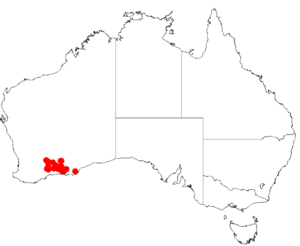Acacia hadrophylla facts for kids
Quick facts for kids Acacia hadrophylla |
|
|---|---|
| Scientific classification | |
| Genus: |
Acacia
|
| Species: |
hadrophylla
|
 |
|
| Occurrence data from AVH | |
Acacia hadrophylla is a special kind of shrub, which is a small, bushy plant. It belongs to a large group of plants called Acacia, also known as wattles. This particular wattle is found only in the southwestern part of Australia. When a plant or animal is found only in one specific area, it's called endemic.
What Does Acacia hadrophylla Look Like?
The Acacia hadrophylla is a dense, spreading shrub. It usually grows to be about 0.3 to 0.5 meters (about 1 to 1.5 feet) tall. It often has a rounded or cone-like shape. Its small branches are covered in fine hairs.
Like many Acacia species, this plant has phyllodes instead of true leaves. Phyllodes are flattened leaf stems that look and act like leaves. The phyllodes of Acacia hadrophylla are thick and stiff. They are shaped like a long oval and curve slightly inwards. They stay green all year round.
These phyllodes are usually 0.7 to 2.5 centimeters long. They are also about 2.5 to 5.5 millimeters wide. You can see four to seven clear, yellowish lines, called nerves, running along them.
This wattle blooms from June to September, producing bright yellow flowers. Its simple flower clusters grow in pairs where the leaf stems meet the main stem (this spot is called the axil). Each flower cluster is a round ball, about 3 to 3.5 millimeters across. Each ball contains 14 to 25 golden-colored flowers.
After the flowers, long, thin seed pods form. These pods are about 1.2 to 2.2 centimeters long and 2 millimeters wide. Inside, they hold brown-black seeds. The seeds are shaped like a long oval and are about 2.5 to 3 millimeters long.
Where Does Acacia hadrophylla Grow?
Acacia hadrophylla is native to a specific part of Western Australia. It grows in the southern areas of the Wheatbelt and Goldfields-Esperance regions.
You can often find it on gently rolling plains. It grows well in sandy, loamy, and clay loam soils. Its distribution is spread out across the landscape. You can find it from places like Mount Holland and Lake King in the west. It also grows as far east as Kumarl and Scaddan.
This plant is often part of open scrub and mallee communities. Mallee is a type of Australian bushland. It has many small eucalyptus trees and shrubs that grow from a large underground root.

